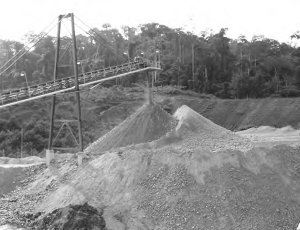VANCOUVER–Red Back Mining (RBI-T, RBIFF-O) is riding the gold tide and raising money again. It was only two months ago that the gold producer had to boost a $40- million financing to $60 million because of strong demand. Now Red Back has arranged another financing, this time to add $150 million to its coffers.
The bought-deal agreement will see Red Back sell 20 million shares at $7.50 apiece, through a syndicate of underwriters led by Cormark Securities, BMO Capital Markets, and GMP Securities. The underwriters have a 2-million-share overallotment option.
In November, Red Back raised $60 million by selling 17 million shares at $3.50 each. In the two months since, the company’s share price has more than doubled to break the $8-mark several times. Its performance highlights the enviable position that low-cost gold producers hold in today’s market.
Red Back owns two gold mines in Africa. In Ghana, the company has a 90% interest in the Chirano mine, which started producing gold in late 2005, and in Mauritania, the company owns the Tasiast gold mine, which began commercial production one year ago.
The last year has been a busy one for Red Back. In addition to running Tasiast for the first time, the company immediately expanded the operation while also managing a major expansion at Chirano. The original plant at Tasiast milled 1.5 million tonnes annually; the expanded plant will handle 2.5 million tonnes per year. Work at the plant is almost finished and Red Back plans to start commissioning the expansion in the coming months.
In addition, Red Back also added an oxide production scenario at Tasiast. The resource contains significant amounts of lower grade oxide material and test-leaching work for a dump-leaching operation returned positive results. The company immediately built a dump-leach pad and recently started irrigating its first dump pile. The leach pads will see some 4 million tonnes of oxide ore averaging 0.6 gram gold per tonne per year, with leaching recovering roughly 52% of the precious metal. The inexpensive operation should add 40,000 oz. gold to Red Back’s 2009 production.
Together, the Tasiast mill and dump-leach operations are expected to produce 230,000 oz. gold at an average cash cost of US$320 per oz. In 2008, the new mill produced 140,054 oz. gold. Tasiast is situated roughly 300 km north of Mauritania’s capital city, Nouakchott.
The potential for expansion at Tasiast is strong. Most of the current resources are within the Piment zone, which is home to five open pits. The latest drill program discovered a new zone of mineralization close to the western limit of the Piment pit design, with a defined strike length now totalling 600 metres. Good intercepts from the new area include 9 metres of 9.95 grams gold from 153 metres depth, 35 metres of 3.15 grams gold from 113 metres down-hole, and 24 metres averaging 6.51 grams gold from 98 metres.
Over at Chirano, roughly 100 km southwest of Kumasi in southern central Ghana, the company produced 120,793 oz. gold in 2008. Red Back expects to increase that to 170,000 oz. in 2009, with cash costs averaging US$480 per oz., after a mill expansion increased throughput to 3.5 million tonnes annually from 2.5 million tonnes.
The other major undertaking at Chirano was development of an underground operation. Until recently, Chirano had been an open-pit operation; more precisely, ore was sourced from a series of 11 small open pits lined up on 9 km of strike. According to a mid-2008 estimate, the open-pit reserve still stands at 28.6 million proven and probable tonnes grading 1.5 grams gold per tonne for 1.4 million oz.
But Red Back has spent considerable effort delineating the Akwaaba Deeps resource, which sits beneath the Akwaaba pit at Chirano, and the effort resulted in an underground resource of 6.1 million indicated tonnes grading 3.4 grams gold per tonne for 1.2 million oz. By the end of 2009, the company plans to be mining that resource at a rate of 100,000 tonnes per month. Underground mining has already begun.
Recent drilling results look set to grow the underground resources at Chirano. Drills hit a new, high-grade structure below the Paboase pit, returning such intercepts as 10 metres of 13 grams gold and 43 metres of 3.54 grams gold. In a recent conference call, management also mentioned another discovery between two planned pits; results have not been released.
All told, the company’s production profile has grown and looks set to continue. The 260,847 oz. gold it produced in 2008 was a 76% increase over its 2007 level; it expects to add another 53% this year to reach 400,000 oz., and in 2010 the company hopes to produce 500,000 oz. gold.
As for the new money, Red Back says it plans to use the $150 million for working capital and general corporate purposes. As of mid-January, the company already had some $37 million in the bank. Kerry Smith, an analyst with Haywood Securities who follows Red Back, says he hopes the company will use the money raised from issuing “a lot of stock” for something accretive, but Red Back remains mum.
The company did make an accretive move in September, when it spent US$27.5 million to pick up 62 million shares of Mineral Deposits (MDM-T, MNLDF-O), an Australian-based company that is developing an underground mine at its Sabodala gold project in Senegal.
On news of the $7.50-per-share financing, Red Back’s share price lost 29¢ to close at $7.52. The company has a 52-week trading range of $3.28-9.25 and has 206 million shares outstanding (not including the latest financing issuance).


Be the first to comment on "Red Back Raises $150M For African Gold Operations"